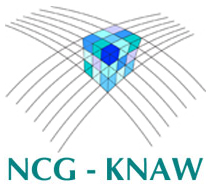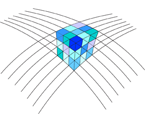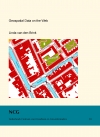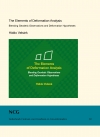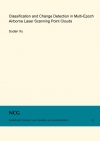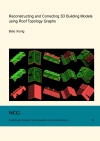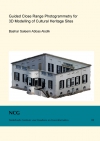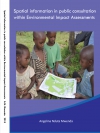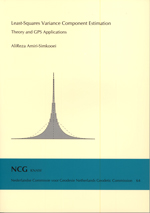
Ali Reza Amiri-Simkooei
Publications on Geodesy 64
Delft, 2007. 220 pagina's. ISBN: 978 90 6132 301 3.
Abstract
Data processing in geodetic applications often relies on the least-squares method, for which one needs a proper stochastic model of the observables. Such a realistic covariance matrix allows one first to obtain the best (minimum variance) linear unbiased estimator of the unknown parameters; second, to determine a realistic precision description of the unknowns; and, third, along with the distribution of the data, to correctly perform hypothesis testing and assess quality control measures such as reliability. In many practical applications the covariance matrix is only partly known. The covariance matrix is then usually written as an unknown linear combination of known cofactor matrices. The estimation of the unknown (co)variance components is generally referred to as variance component estimation (VCE).
In this thesis we study the method of least-squares variance component estimation (LSVCE) and elaborate on theoretical and practical aspects of the method. We show that LS-VCE is a simple, flexible, and attractive VCE-method. The LS-VCE method is simple because it is based on the well-known principle of least-squares. With this method the estimation of the (co)variance components is based on a linear model of observation equations. The method is flexible since it works with a user-defined weight matrix. Different weight matrix classes can be defined which all automatically lead to unbiased estimators of (co)variance components. LS-VCE is attractive since it allows one to apply the existing body of knowledge of least-squares theory to the problem of (co)variance component estimation. With this method, one can 1) obtain measures of discrepancies in the stochastic model, 2) determine the covariance matrix of the (co)variance components, 3) obtain the minimum variance estimator of (co)variance components by choosing the weight matrix as the inverse of the covariance matrix, 4) take the a-priori information on the (co)variance component into account, 5) solve for a nonlinear (co)variance component model, 6) apply the idea of robust estimation to (co)variance components, 7) evaluate the estimability of the (co)variance components, and 8) avoid the problem of obtaining negative variance components.
LS-VCE is capable of unifying many of the existing VCE-methods such as MINQUE, BIQUE, and REML, which can be recovered by making appropriate choices for the weight matrix. An important feature of the LS-VCE method is the capability of applying hypothesis testing to the stochastic model, for which we rely on the w-test, v-test, and overall model test. We aim to find an appropriate structure for the stochastic model which includes the relevant noise components into the covariance matrix. The w-test statistic is introduced to see whether or not a certain noise component is likely to be present in the observations, which consequently can be included in the stochastic model. Based on the normal distribution of the original observables we determine the mean and the variance of the w-test statistic, which are zero and one, respectively. The distribution is a linear combination of mutually independent central chi-square distributions each with one degree of freedom. This distribution can be approximated by the standard normal distribution for some special cases. An equivalent expression for the w-test is given by introducing the v-test statistic. The goal is to decrease the number of (co)variance components of the stochastic model by testing the significance of the components. The overall model test is introduced to generally test the appropriateness of a proposed stochastic model.
We also apply LS-VCE to real data of two GPS applications. LS-VCE is applied to the GPS geometry-free model. We present the functional and stochastic model of the GPS observables. The variance components of different observation types, satellite elevation dependence of GPS observables’ precision, and correlation between different observation types are estimated by LS-VCE. We show that the precision of the GPS observables clearly depends on the elevation angle of satellites. Also, significant correlation between observation types is found. For the second application we assess the noise characteristics of time series of daily coordinates for permanent GPS stations. We apply LS-VCE to estimate white noise and power-law noise (flicker noise and random walk noise) amplitudes in these time series. The results confirm that the time series are highly time correlated. We also use the w-test statistic to find an appropriate stochastic model of GPS time series. A combination of white noise, autoregressive noise, and flicker noise in general best characterizes the noise in all three position components. Unmodelled periodic effects in the data are then captured by a set of harmonic functions, for which we rely on least-squares harmonic estimation (LS-HE) developed in the same framework as LS-VCE. The results confirm the presence of annual and semiannual signals, as well as other significant periodic patterns in the series. To avoid the biased estimation of the variance components, such sinusoidal signals should be included in the functional part of the model before applying LS-VCE.
Contents
Abstract i
- Introduction 1
- Least-Squares Estimation and Validation 5
- Variance Component Estimation: A Review 21
- Least-Squares Variance Component Estimation 33
- Detection and Validation in Stochastic Model 69
- Multivariate Variance-Covariance Analysis 99
- GPS Geometry-Free Model 113
- GPS Coordinate Time Series 131
- Conclusions and Recommendations 159
- Mathematical Background 165
- Derivation of Equations 167
- Moments of Normally Distributed Data 173
- Mixed model with hard constraints 181
Bibliography 185
Index 195
Notation and Symbols 199
Abstract (in Dutch) 203
Curriculum Vitae 205
Samenvatting
Gegevensverwerking in geodetische toepassingen vindt doorgaans plaats op basis van de kleinste kwadraten methode. Hiervoor is een goed stochastisch model van de waarnemingsgrootheden nodig. Met een dergelijke realistische covariantie-matrix wordt ten eerste de beste (minimum variantie) lineaire zuivere schatter voor de onbekende parameters verkregen, en kan ten tweede een realistische precisiebeschrijving van de parameters gegeven worden, en kan ten derde, op basis van de verdeling van de waarnemingsgrootheden, hypothese toetsing correct uitgevoerd worden, en kunnen maten voor kwaliteitscontrole bepaald worden, zoals voor betrouwbaarheid. In veel praktische toepassingen is de covariantie-matrix slechts gedeeltelijk bekend. De covariantie-matrix wordt gewoonlijk uitgedrukt als een onbekende lineaire combinatie van een aantal bekende cofactor matrices. Het schatten van de onbekende (co)variantie componenten wordt in het algemeen variantiecomponentenschatting (VCS) genoemd, en ook wel kansmodelschatting.
In dit proefschrift bestuderen we de methode van kleinste kwadraten variantiecomponenten-schatting (KK-VCS) en werken we theoretische en praktische aspecten uit. We laten zien dat de KK-VCS methode een eenvoudige, flexibele en aantrekkelijke methode is voor VCS. De KK-VCS is eenvoudig, daar ze gebaseerd is op het bekende kleinste kwadraten principe. Met deze methode is de schatting van de (co)variantiecomponenten gebaseerd op een lineair model van waarnemingsvergelijkingen. De methode is flexibel omdat ze werkt met een door de gebruiker gedefinieerde gewichtsmatrix. Verschillende klassen van gewichtsmatrices kunnen gedefinieerd worden, die allemaal automatisch tot zuivere schatters voor de (co)variantie componenten leiden. KKVCS is aantrekkelijk omdat men de bestaande kleinste kwadraten theorie kan toepassen op het probleem van variantie-componenten-schatting. Met deze methode kan men 1) maten voor discrepantie in het stochastisch model verkrijgen, 2) de covariantie-matrix bepalen van de (co)variantie componenten, 3) de minimum variantie schatter verkrijgen voor de (co)variantie componenten door de inverse van de covariantie-matrix als gewichtsmatrix te nemen, 4) a-priori informatie over de (co)variantie componenten in rekening brengen, 5) een niet-lineair (co)variantie componenten model oplossen, 6) robuuste schatting toepassen op variantie componenten, 7) de schatbaarheid van (co)variantie componenten evalueren, en 8) het probleem van negatieve variantie componenten voorkomen.
Met KK-VCS kunnen vele bestaande VCS methoden, zoals MINQUE, BIQUE, en REML in één raamwerk geplaatst worden. Deze methoden worden verkregen door speciale keuzes voor de gewichtsmatrix te maken. Een belangrijke eigenschap van de KK-VCS methode is de mogelijkheid om hypothese toetsing toe te passen op het stochastisch model. We gebruiken hiervoor de w-toets, de v-toets, en de globale toets. Ons doel is om een geschikte structuur te vinden voor het stochastisch model, dat alle relevante ruiscomponenten in de covariantie-matrix herbergt. De w-toets wordt geïntroduceerd om te kunnen vaststellen of een bepaalde ruiscomponent met waarschijnlijkheid aanwezig is in de waarnemingen, en dientengevolge opgenomen moet worden in het stochastisch model. Gebaseerd op de normale verdeling voor oorspronkelijke waarnemingsgrootheden leiden we de verwachting en de variantie van de w-toetsgrootheid af, welke nul en één zijn, respectievelijk. De verdeling is een lineaire combinatie van onderling onafhankelijke centrale chi-kwadraat verdelingen, elk met één vrijheidsgraad. In een aantal speciale gevallen kan deze verdeling benaderd worden door een standaard normale verdeling. Als een equivalente uitdrukking voor de w-toets wordt de v-toetsgrootheid gegeven. Het doel is om het aantal (co)variantie componenten in het stochastisch model te reduceren, door de significantie van de componenten te toetsen. De globale toets functioneert als een algemene toets op de geschiktheid van het aangenomen stochastisch model.
KK-VCS is toegepast op meetgegevens uit twee GPS toepassingen. Als eerste is de methode toegepast op het GPS geometrievrije model. Daartoe worden het functiemodel en het stochastisch model opgesteld. De variantiecomponenten van verschillende waarnemingstypen, de satelliet-elevatie afhankelijkheid van de precisie van GPS waarnemingsgrootheden, en de correlatie tussen verschillende waarnemingstypen worden geschat met KK-VCS. We laten zien dat de precisie van GPS waarnemingsgrootheden duidelijk afhangt van de elevatie van de satelliet. Ook is er een significante correlatie tussen de waarnemingstypen. Als tweede toepassing worden de ruiskarakteristieken in tijdreeksen van dagelijkse coördinaten van permanente GPS stations bepaald. De KK-VCS is toegepast om de amplitudes van witte ruis en power-law ruis (flicker ruis en random walk ruis) in deze tijdreeksen te schatten. De resultaten bevestigen dat de tijdreeksen behoorlijk gecorreleerd in de tijd zijn. We hebben ook de w-toetsgrootheid gebruikt om een geschikt stochastisch model voor de GPS tijdreeksen te vinden. Een combinatie van witte ruis, autoregressieve ruis, en flicker ruis karakteriseert in het algemeen de ruis in alle drie positie componenten het beste. Ongemodelleerde periodieke effecten in de metingen worden beschreven door een stel harmonische functies. Deze worden geschat met behulp van de kleinste kwadraten methode, in hetzelfde raamwerk als KK-VCS. De resultaten bevestigen de aanwezigheid van jaarlijkse en halfjaarlijkse signalen in de reeksen, als ook andere significante periodieke patronen. Om onzuivere schatting van de variantiecomponenten te voorkomen, dienen dergelijke sinusvormige signalen in het functiemodel opgenomen te worden, alvorens KKVCS toe te passen.
